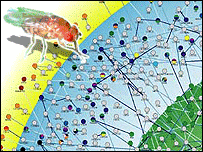| Scientists hail new 'map of life': the Protein Interaction Map |
|||||||
Proteins, which are made by genes, are the building blocks of tissues as well as the basis for molecular interactions that enable an organism to live. The protein interaction map will allow a new insight into a highly complex metabolic system, similar in many ways to the human one. The research is to be published in a future issue of the journal Science. 'A starting point' Scientists, from the US biotech company CuraGen in association with several US Universities, have produced a draft map of 20,405 interactions between 7,048 proteins in the fruit fly. This map is a starting point for what is being called a systems biology modelling of animals including humans, say the researchers in their report. For decades the fruit fly has been opening the door to a better understanding of genetics. Its small genetic blueprint or genome, small size and short lifespan has made it an invaluable aid to study how genes work. It also has many of its genes in common with humans and so has provided a way to study human diseases.
Dance of proteins An organism's genome is a two-dimensional and static description of a living creature. To come to life it must be translated into action, rather like a screenplay must be turned into acting. Genes in the nucleus of a cell act as templates to produce proteins, which move out into the cell to perform a specific task, or to get together with other proteins to make a larger structure. Many proteins interact with others, for example, to liberate the energy a cell requires to function. In its complexity and simplicity, life is a dance of proteins. There is the genome - the master genetic blueprint - that resides in the cell nucleus. It interacts with ribosomes - which turn the DNA code into proteins.
A protein called tubulin forms a molecular scaffold along which proteins can be transported around the cell. Some go to the cell's outer membrane and are ejected. Knowledge of how proteins behave and interact is essential for any understanding of life itself. So, having completed the decoding an organism's genome, scientists now want to make a protein map - its proteome. 'A real tour de force' The new protein interaction map means that the fruit fly's proteome is probably the best studied to date. "The Science publication is a real tour de force in systems biology," says Richard Lifton of CuraGen and the Yale University School of Medicine. Dr John Chant of CuraGen told BBC News Online: "When I look at the new map I can see how complicated it is. But as well as that there is a beauty to it. The map undoubtedly contains a massive amount of information." "The vast amount of important new information reported in this paper will provide researchers around the globe with productive avenues to pursue for years to come," says Richard Lifton. "Much of our understanding of the complex biochemical pathways that underlie human disease has been derived from the study of the fruit fly, and having the opportunity to integrate this huge proteomic dataset with prior knowledge of this well-studied organism will be a boon to the understanding of normal biology, as well as human disease," he adds. Molecular snapshot To make the map scientists cloned all the fruit fly's genes and developed a way to take a molecular 'snapshot' of what was going on inside the organism. They say they have obtained data about "a significant fraction of the organism's protein-protein interactions". "We have had biologists, bioinformation scientists and computer scientists working together very closely over this," Dr John Chant told BBC News Online. They tracked more than 20,000 interactions involving approximately 7,000 genes. Mathematical modelling of the interactions between apparently disconnected proteins revealed a hidden level of organisation between genes. The beginnings of a new order are being glimpsed with local activity that links multiprotein complexes as well as 'global' interconnections among and within various protein complexes. The map will have direct relevance to humans. "Given the proven utility of Drosophila (fruit flies) as a model system, many of the linkages uncovered in this report should be examined for their conservation in human cells," the researchers say. |
|||||||
